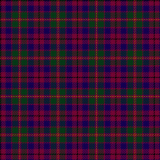Tartan of the Duke of Lancaster's Regiment

When one thinks of Scotland, many iconic images come to mind; rolling green hills, ancient castles, and Nessie swimming in her loch. Even more memorable than these, however, is the patterned fabric which has come to symbolize Scottish culture itself: Tartan is the only textile design in the world of which a tiny scrap can evoke such feelings of pride, such identification with the historical struggles of Scots, and identification with those desirable traits associated with being Scottish - honesty, industriousness and bravery in battle.*
Although tartan-style fabrics have a very long history – a good portion of it not Scottish – today these textiles are most famous as badges of identification. Specific colors and their arrangements function as a symbolic language in their own right, representing individuals, families and clans, as well as professional groups, companies, and organizations. To the huge international family of Scots and their descendants - estimated at 40 to 60 million around the globe - tartan represents everything that is admirable and wholesome about the land of their fathers.*
This tartan celebrates all past, present, and future personnel and achievements attached to the Duke of Lancaster’s Regiment. Formed on 1st July 2006, by the amalgamation of the King's Own Royal Border Regiment, the King's Regiment, and the Queen's Lancashire Regiment. With a strong history and proud tradition dating back to 1680 with the formation of the 4th, or King’s Own Regiment of Foot, raised by King Charles II. This tartan features the Duke of Lancaster’s Regimental Colours: royal blue, orange, deep green and maroon. Black is for continual respect for all fallen Duke of Lancaster’s comrades. The Duke of Lancaster's Regiment is the Infantry Regiment of the North West of England. They have two regular battalions and one reserve battalion. Fierce, strong and courageous, they are known as ‘The Lions of England’.**
*http://www.tartansauthority.com/tartan/
**https://www.tartanregister.gov.uk/tartanDetails?ref=12386
© Symbols.com
